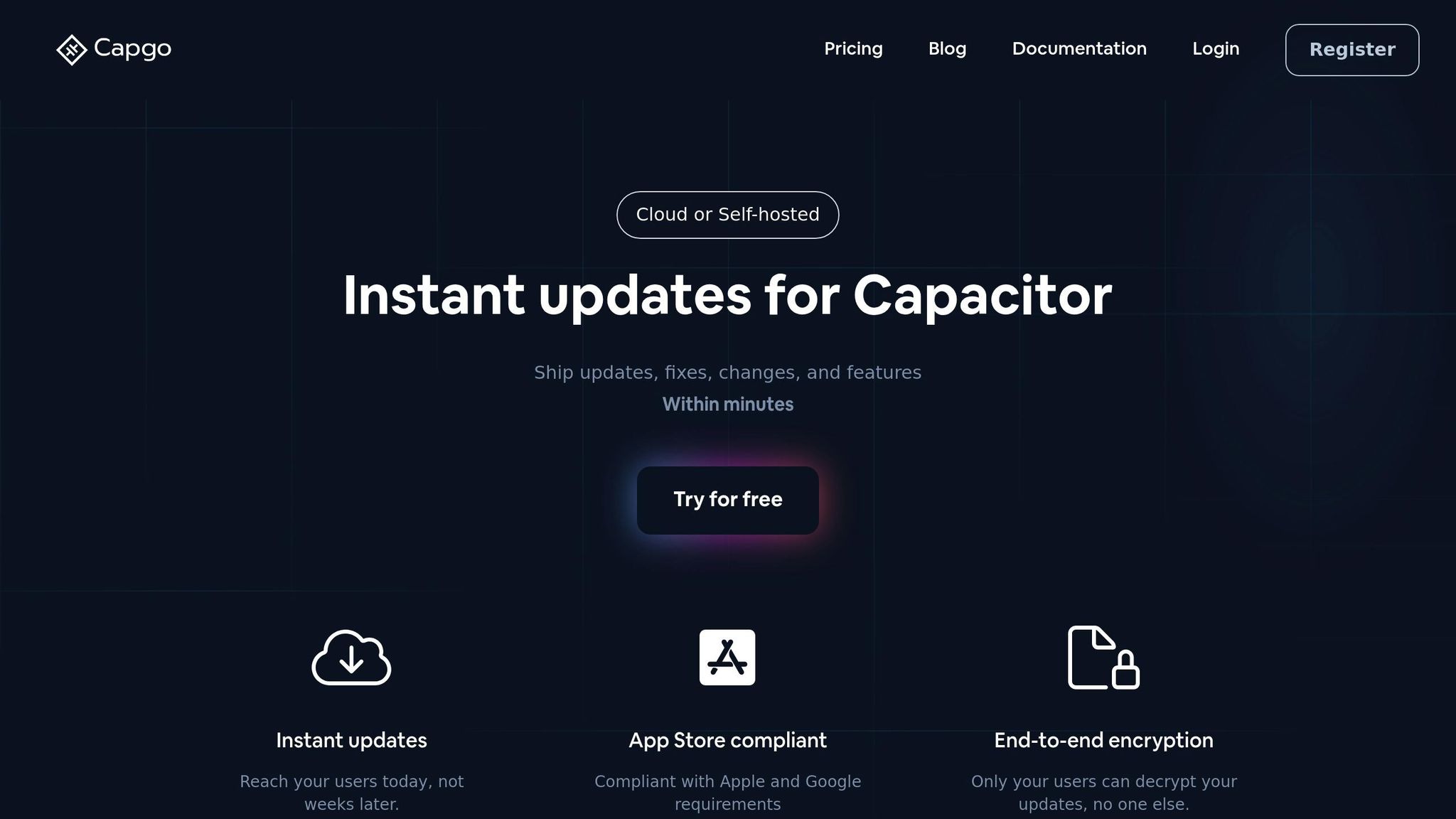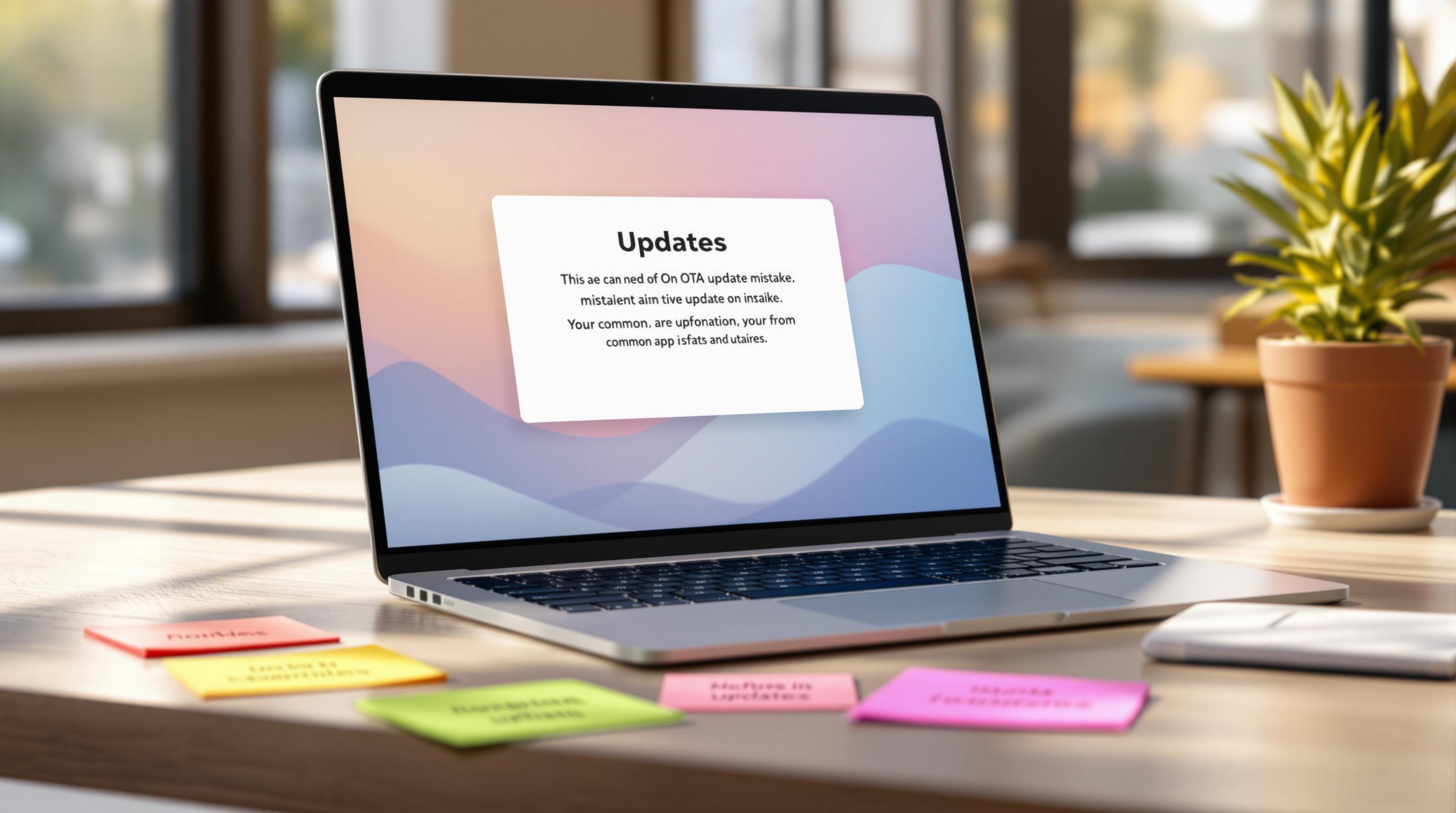Want secure OTA updates in your CI/CD pipeline? Here’s what you need to know:
- Use secure communication protocols: Implement TLS 1.3, HTTPS, and SSL pinning to prevent tampering or interception during updates.
- Sign updates with cryptographic keys: Verify update integrity using Public Key Infrastructure (PKI) and secure bootloaders.
- Encrypt end-to-end: Protect updates throughout their journey with end-to-end encryption (E2EE).
- Secure your CI/CD pipeline: Manage credentials with secret management tools, isolate build environments, and enforce Role-Based Access Control (RBAC).
- Automate security testing: Run pre-deployment scans (SAST, SCA, DAST) to catch vulnerabilities early.
- Monitor and prepare for rollbacks: Track update performance and implement rollback mechanisms like A/B partitioning.
- Stay compliant: Maintain audit logs, follow app store guidelines, and set approval workflows for critical updates.
Practical Steps for Securing CI/CD Pipelines | Secure Software Delivery | OpsMx Delivery Shield
Setting Up Basic Security for OTA Updates
Securing OTA updates involves multiple layers of protection: secure communication protocols, cryptographic signing, and end-to-end encryption. Each layer addresses specific risks and works together to create a solid defense system.
Using Secure Communication Protocols
To protect the communication between devices and update servers, you need reliable and secure channels. Transport Layer Security (TLS) is the go-to protocol here, with TLS 1.3 being the current standard for safeguarding data during transmission [1].
When implementing TLS, devices must authenticate the server’s identity. This can be done using either Certificate Authority validation provided by the operating system or pre-distributed keys like self-signed certificates [1]. This step ensures that attackers cannot impersonate legitimate update servers.
HTTPS encryption should be mandatory for all interactions between the client and server to block man-in-the-middle attacks [2]. Additionally, using SSL pinning ensures that your application only trusts specific SSL certificates, even if a Certificate Authority has been compromised [2].
The communication protocol must fulfill three key roles: authenticating the connection to access updates, securing the exchange of inventory data, and protecting the delivery of status information [1]. Each of these areas represents a potential vulnerability if not secured.
Once the communication is secure, the next step is to guarantee update integrity through cryptographic signing.
Signing Updates with Cryptographic Keys
Cryptographic signing ensures that update packages are both untampered and from trusted sources. Public Key Infrastructure (PKI) is the most reliable framework for this purpose [3].
Here’s how it works: developers sign update packages with a private key before deployment. Devices then use the corresponding public key to verify the signature during the update process. Any package failing this verification is rejected [3].
A secure bootloader adds another layer of protection. During startup, it checks the software’s authenticity and integrity using cryptographic techniques like hash functions or digital signatures [3]. This prevents malicious code from running, even if it has been installed.
Key management is essential for maintaining long-term security. Below is a quick reference table for handling different threat levels:
| Alert Level | Trigger | Response Action |
|---|---|---|
| Low | Unusual access patterns | Investigate and document findings |
| Medium | Multiple failed operations | Temporarily suspend key usage |
| High | Confirmed compromise | Rotate the key immediately |
| Critical | Active exploit detected | Replace all system keys |
After ensuring update integrity, the final step is to protect confidentiality with end-to-end encryption.
Setting Up End-to-End Encryption
End-to-end encryption (E2EE) secures the entire pathway between your build system and user devices. This approach ensures that even the platform delivering updates cannot access or alter the content. It protects against tampering, code injection, and data breaches during delivery.
To implement E2EE, encrypt update packages before they leave your development environment. Use secure key exchange protocols to share encryption keys and verify their authenticity on the target device. Strong encryption methods combined with secure key management form the backbone of this system.
Platforms like Capgo simplify this process by offering built-in end-to-end encryption for Capacitor apps. Capgo manages the encryption process while adhering to Apple and Android security requirements, saving you the effort of building a custom system and reducing potential vulnerabilities.
Automating encryption through CLI tools can further streamline the process. This minimizes human error and ensures consistent application of security measures across all updates. By integrating encryption into your CI/CD pipeline, you can secure packages during deployment without compromising development speed or efficiency.
Securing CI/CD Pipelines Against Attacks
Your CI/CD pipeline is a tempting target for attackers looking to inject malicious code into OTA updates. If compromised, it can distribute harmful code quickly, making its security a top priority. To protect your workflow, focus on securing credentials, isolating build environments, and enforcing strict access controls. These measures work hand-in-hand with earlier strategies aimed at safeguarding OTA update delivery.
Managing Credentials and API Keys
Storing sensitive information like API keys, database credentials, or signing certificates directly in your code repositories is a major security risk. Attackers actively seek out these vulnerabilities, and secrets stored in version control systems are especially exposed [5].
Modern CI/CD platforms offer secret management tools that keep credentials secure. These tools inject credentials during builds without exposing them in project files or logs, ensuring only authorized users can access them [5].
Here are a few popular options for managing secrets:
| Platform | Features | Best For |
|---|---|---|
| HashiCorp Vault | Dynamic secrets, encryption, fine-grained access control | Large-scale operations |
| AWS Secrets Manager | Seamless AWS integration, automatic rotation | AWS-centric setups |
| Azure Key Vault | Certificate handling, key rotation | Microsoft environments |
Rotating secrets regularly, ideally through automated processes, reduces the risk window for vulnerabilities [4]. Additionally, implementing Single Sign-On (SSO) and Multi-Factor Authentication (MFA) significantly decreases the likelihood of credential-based attacks, with MFA alone cutting this risk by over 90% [5].
Isolating Build Environments
Keeping build environments isolated is another critical step. Each build should start from a clean, secure state - free of leftover configurations, cached files, or unverified dependencies [5]. This reduces the risk of cross-contamination between builds and simplifies auditing for security purposes.
Using temporary runners or containerized builds, such as Docker, ensures a consistent and isolated environment for every build. These containers start from a known, secure base image, minimizing exposure to vulnerabilities.
Additionally, segment your pipeline to keep development, testing, and production environments completely separate [7]. By granting each stage only the permissions it needs, you limit the potential damage from a single breach [8].
Setting Up Role-Based Access Control
Role-Based Access Control (RBAC) is essential for maintaining the integrity of your pipeline and OTA updates. RBAC ensures team members only have access to the stages of the pipeline necessary for their roles. This approach ties directly into securing credentials and isolating environments. By following the principle of least privilege, you can define clear roles like developers, testers, security reviewers, and deployment managers, each with permissions tailored to their tasks [6].
Most CI/CD platforms include built-in RBAC features. For example:
- Jenkins: Offers matrix-based security and role strategy plugins.
- GitLab: Supports project-level permissions and group management.
- GitHub Actions: Enforces repository permissions and environment protection rules.
Regularly auditing roles and permissions helps identify and remove unnecessary access, ensuring privileges align with current responsibilities [6]. For added security, require multi-factor authentication for sensitive operations, such as production deployments or configuration changes.
Some platforms, like Capgo, integrate RBAC directly into update management systems. This allows granular control over who can deploy updates to specific user segments. Developers can test changes in controlled environments while only authorized team members push updates to production devices, maintaining tight control over the process.
Automated Security Testing for OTA Updates
Automated security testing plays a critical role in identifying vulnerabilities before software reaches production. With supply chain attacks skyrocketing by over 600% in 2022, incorporating thorough security scans into your CI/CD pipeline is essential. These automated tests safeguard users and uphold trust by ensuring security at every stage, from the initial commit to deployment.
Running Pre-Deployment Security Scans
While secure update mechanisms are foundational, pre-deployment security scans add an extra layer of protection by catching vulnerabilities early. This proactive approach shifts security to the earlier phases of development, minimizing risks downstream.
Static Application Security Testing (SAST) tools focus on analyzing your source code without executing it. They identify potential vulnerabilities during development. For example, tools like Spectral provide real-time feedback while keeping false positives to a minimum [9].
Software Composition Analysis (SCA) tools examine your project’s dependencies, comparing them against known vulnerability databases. For instance, npm-Audit for JavaScript projects and Nancy for Golang dependencies automatically flag issues within your dependency chain [10].
Dynamic Application Security Testing (DAST) tools simulate real-world attack scenarios to uncover vulnerabilities that static tools might miss. Free options like Dastardly by Burp Suite are designed for CI/CD pipelines, while ZAP offers proxy-based traffic analysis to detect vulnerabilities in real-time [9] [10].
| Tool Category | Example Tools | Primary Function |
|---|---|---|
| SAST | Spectral, Coverity, Semgrep | Scan source code for vulnerabilities |
| SCA | npm-Audit, Nancy | Check dependencies for known security issues |
| DAST | Dastardly, ZAP | Test running applications for vulnerabilities |
| Container Security | Trivy, Anchore | Scan container images and configurations |
Infrastructure as Code (IaC) scanning tools, such as KICS and Prowler, review deployment configurations for insecure settings before they are implemented. This step is crucial for protecting your OTA update infrastructure from misconfigurations that could lead to potential attacks [10].
Monitoring Updates and Detecting Problems
Once updates are securely deployed, continuous monitoring ensures any issues are detected in real time. This includes spotting failed updates, unauthorized access attempts, or unusual network activity that might indicate a security breach.
- Update Success Monitoring tracks metrics like download success rates, installation completions, and overall device health post-update. Sudden declines in these metrics or unusual error patterns could signal corrupted updates or security concerns.
- Network Activity Analysis monitors traffic behavior during updates. Be vigilant for unexpected data transfers, connections to unauthorized servers, or unusual bandwidth usage, which may point to tampered updates or man-in-the-middle attacks.
- Device Behavior Monitoring looks for anomalies in device performance after updates. For example, spikes in CPU, memory, or network usage could indicate malicious activity. Collecting telemetry data across your device fleet allows for quicker identification of these patterns.
Platforms like Capgo simplify monitoring by integrating real-time update tracking directly into your CI/CD workflows. This kind of oversight enables swift rollback and recovery actions when needed.
Setting Up Rollback and Recovery Options
Automated rollback systems are essential to maintaining device functionality when updates fail or introduce security issues. A dual-bank (A/B partitioning) setup ensures there’s always a backup firmware version available. The system validates new updates, and if any checks fail, it reverts to the previous trusted version automatically [11].
Other measures, such as watchdog timers and staged rollouts, further reduce risks. Staged rollouts begin with a small group of devices and gradually expand, limiting the impact of potential issues and enabling quick rollbacks when necessary.
Recovery Testing is equally important. Simulating failure scenarios - like power outages, network interruptions, or corrupted downloads - helps confirm that your rollback mechanisms work as intended under real-world conditions [11].
Although only 36% of security teams currently adopt full DevSecOps practices [10], integrating automated security testing into your pipeline strengthens your defenses. Using tools that consolidate multiple security assessments can streamline the process, ensuring your CI/CD pipeline meets rigorous security requirements.
Meeting Compliance and Audit Requirements
When it comes to deploying OTA updates, regulatory compliance isn’t just a box to check - it’s a critical safeguard for both your organization and your users. By pairing robust update delivery with secure CI/CD practices, you can build a strong foundation that helps meet these requirements.
Creating Permanent Audit Logs
Audit logs are indispensable for keeping track of every change and access event. Whether you’re capturing deployment activities in JSON or syslog format, these logs ensure full traceability [12][13].
Centralized logging plays a key role here. By aggregating logs from various CI/CD components into a single location, you can analyze and correlate events more effectively. This setup helps identify suspicious activities and streamlines monitoring. Sending these logs to a centralized log management system or a Security Information and Event Management (SIEM) platform enhances your ability to monitor and respond to potential threats [13].
| Tracking Component | Purpose | Security Benefit |
|---|---|---|
| Error Logging | Tracks update failures | Detects breaches |
| Analytics Dashboard | Monitors success rates | Identifies potential threats |
| Version Control | Tracks active versions | Ensures consistency |
| User Activity Logs | Records deployments | Provides an audit trail |
Real-time monitoring of your CI/CD pipeline is essential for spotting anomalies, such as unexpected changes or unusual access patterns. Implement alerting mechanisms to notify your team when security issues arise. However, strike a balance - configure alerts to avoid overwhelming your team with false positives [12][13].
“Security isn’t something to bolt on later - it’s a foundation. Build it into your pipeline from day one, and you’ll save yourself the pain of patching gaps and cleaning up after attackers.” - SpectralOps [14]
Regular reviews of audit logs ensure that access is limited to those who genuinely need it. They also help uncover inconsistencies that might indicate security problems. Make sure your logging practices align with your organization’s policies and meet the standards required for regulatory compliance [13].
Following App Store Guidelines
Both Apple and Google enforce strict rules for OTA updates, which include specific security protocols and user consent requirements. Tools like Capgo come with built-in features designed to align with these platform security standards.
Beyond security, app store guidelines emphasize a seamless user experience. Updates should not disrupt core functionality, and users must be notified about significant changes. Additionally, your OTA solution must adhere to platform-specific rules about update frequency and file size to avoid policy violations.
Documentation is another key element. Keep detailed records of update contents, security measures, and their impact on users. These records not only support app store reviews but also demonstrate your commitment to meeting platform guidelines.
Setting Up Approval Workflows
While automation strengthens security and compliance, structured approval workflows add a critical human layer of oversight. For example, requiring multi-person reviews for Release Activations ensures that updates undergo thorough scrutiny before they go live [15].
Role-based permissions are essential here. Assign specific responsibilities - like having senior developers approve code changes and security specialists validate encryption and compliance measures. This approach ensures that updates are reviewed by the right experts.
A tiered approval system can further refine the process. For instance:
- Minor bug fixes might require only a single approver.
- Major updates or security patches should involve multiple reviewers from different teams.
Integrating approval workflows with your existing project management and communication tools can streamline the process. Automated notifications keep reviewers informed when their input is needed, while detailed change logs provide the context necessary for informed decisions. Monitoring approval times and identifying bottlenecks can help optimize the workflow without compromising security.
Best Practices for Secure OTA Updates
Securing over-the-air (OTA) updates in your CI/CD pipeline is a mix of automation and careful human oversight. With unpatched firmware responsible for 60% of IoT security breaches [16], these practices are not just helpful - they’re critical for safeguarding both your users and your business.
Key Security Requirements
Four key pillars form the foundation of secure OTA updates. First, end-to-end encryption protects update packages from tampering during transit. Second, cryptographic signing ensures that only verified updates make it to users’ devices.
The next layer of protection lies in your CI/CD pipeline. This involves proper credential management, isolated build environments, and role-based access controls to restrict who can deploy updates.
| Feature | Security Benefit |
|---|---|
| Encryption | Protects update packages |
| Rollback Options | Allows quick fixes |
| Access Control | Restricts permissions |
| Analytics | Monitors performance |
Automated validation is another vital step. Pre-deployment security scans, automated testing, and continuous monitoring can detect vulnerabilities early. Pair these with audit logs and approval workflows to establish strong security checkpoints.
When combined, these measures create a solid foundation for using specialized tools to enhance your OTA update process.
Using Tools Like Capgo

Once you’ve established core security practices, platforms like Capgo make implementation easier. With 23.5 million updates delivered across 750 apps, Capgo showcases how secure OTA systems can scale effectively.
Capgo simplifies security by offering end-to-end encryption and seamless CI/CD integration, reducing the manual configurations that often lead to vulnerabilities. Additionally, its compliance with Apple and Android requirements means you can focus on updates without worrying about app store guidelines.
The platform also provides rollback capabilities and version control, serving as essential safety nets when updates encounter issues. Instead of scrambling to resolve a faulty update, you can quickly revert to a stable version while addressing the issue. Coupled with real-time analytics, you can identify and respond to problems as they arise.
With these tools and practices in place, you’ll be ready to take the next steps toward securing your OTA updates.
Getting Started with Secure OTA Updates
Start by auditing your current CI/CD pipeline for security gaps. Pay close attention to credential management - ensure that API keys, signing certificates, and other sensitive data are stored securely and accessed only by authorized processes.
Encrypt every step of the update process. This includes encrypting update packages, using HTTPS for communications, and securing your build environment. Set up logging and monitoring tools to maintain full visibility into your pipeline.
Introduce approval workflows for critical updates. Even if routine patches are automated, having a human review process for major changes adds an extra layer of security. Over time, refine these workflows to strike the right balance between speed and oversight.
Finally, test rollback procedures and conduct quarterly security reviews to stay ahead of emerging threats. Being prepared can make all the difference when responding to a security incident.
FAQs
::: faq
What are the key security risks of OTA updates in CI/CD pipelines, and how can developers address them?
Over-the-air (OTA) updates in CI/CD pipelines come with their share of risks, including data interception, code tampering, and server breaches. These vulnerabilities can jeopardize app integrity, expose sensitive user information, or even allow unauthorized updates to slip through.
To address these challenges, developers should focus on key security measures like end-to-end encryption, code signing, and using secure protocols such as HTTPS. Adding strong authentication methods and scheduling regular security audits further strengthens the update process. Tools like Capgo can simplify this by offering features such as encrypted updates, smooth CI/CD integration, and adherence to Apple and Android guidelines.
By implementing these strategies, developers can keep OTA updates secure and reliable, ensuring a safer experience for users while meeting industry standards. :::
::: faq
How does cryptographic signing protect OTA updates, and what is the role of Public Key Infrastructure (PKI)?
Cryptographic signing plays a crucial role in ensuring OTA updates are secure and trustworthy. By leveraging Public Key Infrastructure (PKI), developers use a private key to sign update packages. Devices receiving these updates then rely on the corresponding public key to confirm two things: the update originates from a trusted source, and it hasn’t been tampered with during transmission.
This method effectively blocks unauthorized or malicious updates, protecting both the device’s functionality and its security. Integrating PKI into your CI/CD pipeline is an essential measure for maintaining secure OTA updates. :::
::: faq
What are the best practices for securing credentials and API keys in a CI/CD pipeline during OTA updates?
To keep credentials and API keys safe in a CI/CD pipeline during OTA updates, here are some key steps to follow:
-
Store secrets securely: Use environment variables or secure vaults instead of embedding sensitive data in your codebase. This approach not only protects your secrets but also makes managing configurations across environments much easier.
-
Restrict permissions: Assign the least amount of access necessary to your keys and credentials. Also, make it a habit to rotate these secrets regularly to minimize potential risks.
-
Scan for leaks automatically: Use tools like
git-secretsto catch accidental exposures early. Pair this with detailed logging and monitoring to quickly spot and respond to unauthorized access attempts.
For those working with Capacitor apps, platforms like Capgo simplify CI/CD integration by offering features such as end-to-end encryption and user-specific update assignments. These tools help ensure your OTA updates are both secure and compliant. :::




